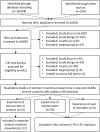Women's and girls' experiences of menstruation in low- and middle-income countries: A systematic review and qualitative metasynthesis
- PMID: 31095568
- PMCID: PMC6521998
- DOI: 10.1371/journal.pmed.1002803
Women's and girls' experiences of menstruation in low- and middle-income countries: A systematic review and qualitative metasynthesis
Abstract
Background: Attention to women's and girls' menstrual needs is critical for global health and gender equality. The importance of this neglected experience has been elucidated by a growing body of qualitative research, which we systematically reviewed and synthesised.
Methods and findings: We undertook systematic searching to identify qualitative studies of women's and girls' experiences of menstruation in low- and middle-income countries (LMICs). Of 6,892 citations screened, 76 studies reported in 87 citations were included. Studies captured the experiences of over 6,000 participants from 35 countries. This included 45 studies from sub-Saharan Africa (with the greatest number of studies from Kenya [n = 7], Uganda [n = 6], and Ethiopia [n = 5]), 21 from South Asia (including India [n = 12] and Nepal [n = 5]), 8 from East Asia and the Pacific, 5 from Latin America and the Caribbean, 5 from the Middle East and North Africa, and 1 study from Europe and Central Asia. Through synthesis, we identified overarching themes and their relationships to develop a directional model of menstrual experience. This model maps distal and proximal antecedents of menstrual experience through to the impacts of this experience on health and well-being. The sociocultural context, including menstrual stigma and gender norms, influenced experiences by limiting knowledge about menstruation, limiting social support, and shaping internalised and externally enforced behavioural expectations. Resource limitations underlay inadequate physical infrastructure to support menstruation, as well as an economic environment restricting access to affordable menstrual materials. Menstrual experience included multiple themes: menstrual practices, perceptions of practices and environments, confidence, shame and distress, and containment of bleeding and odour. These components of experience were interlinked and contributed to negative impacts on women's and girls' lives. Impacts included harms to physical and psychological health as well as education and social engagement. Our review is limited by the available studies. Study quality was varied, with 18 studies rated as high, 35 medium, and 23 low trustworthiness. Sampling and analysis tended to be untrustworthy in lower-quality studies. Studies focused on the experiences of adolescent girls were most strongly represented, and we achieved early saturation for this group. Reflecting the focus of menstrual health research globally, there was an absence of studies focused on adult women and those from certain geographical areas.
Conclusions: Through synthesis of extant qualitative studies of menstrual experience, we highlight consistent challenges and developed an integrated model of menstrual experience. This model hypothesises directional pathways that could be tested by future studies and may serve as a framework for program and policy development by highlighting critical antecedents and pathways through which interventions could improve women's and girls' health and well-being.
Review protocol registration: The review protocol registration is PROSPERO: CRD42018089581.
Conflict of interest statement
The authors have declared that no competing interests exist.
Figures


References
-
- George R. Celebrating Womanhood: How Better Menstrual Hygiene Management Is the Path to Better Health, Dignity and Business: Break the Silence! Geneva, Switzerland: WSSCC, 2013.
-
- Dolan CS, Ryus CR, Dopson S, Montgomery P, Scott L. A Blind Spot in Girls’ Education: Menarche and Its Webs of Exclusion in Ghana. Journal of International Development. 2014;26(5):643–57. 10.1002/jid.2917 - DOI
Publication types
MeSH terms
LinkOut - more resources
Full Text Sources
Medical

